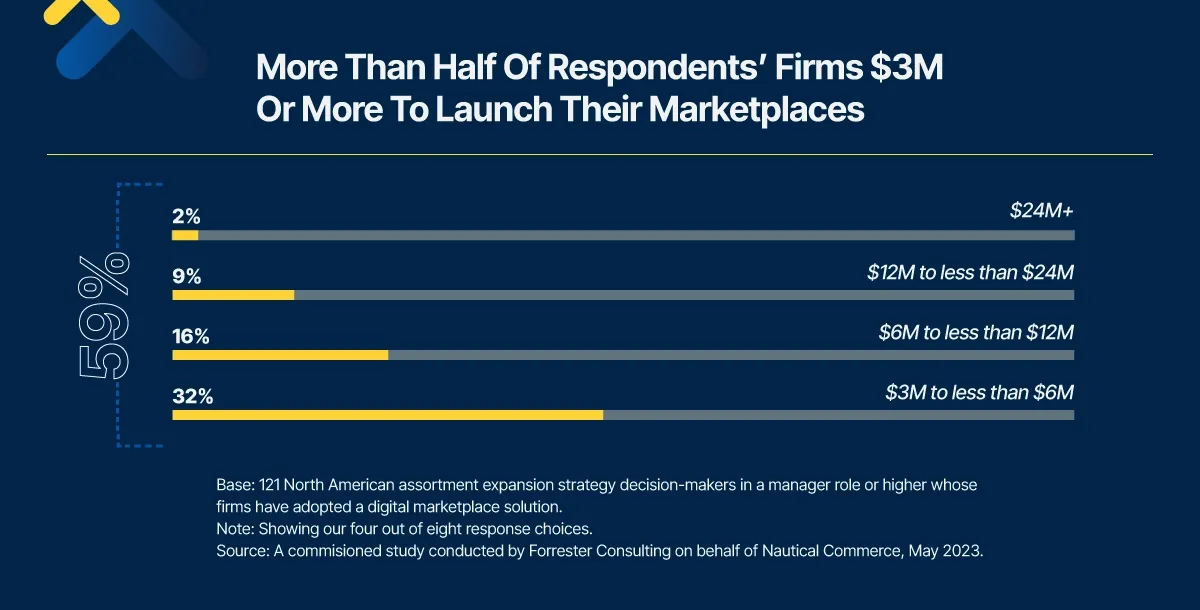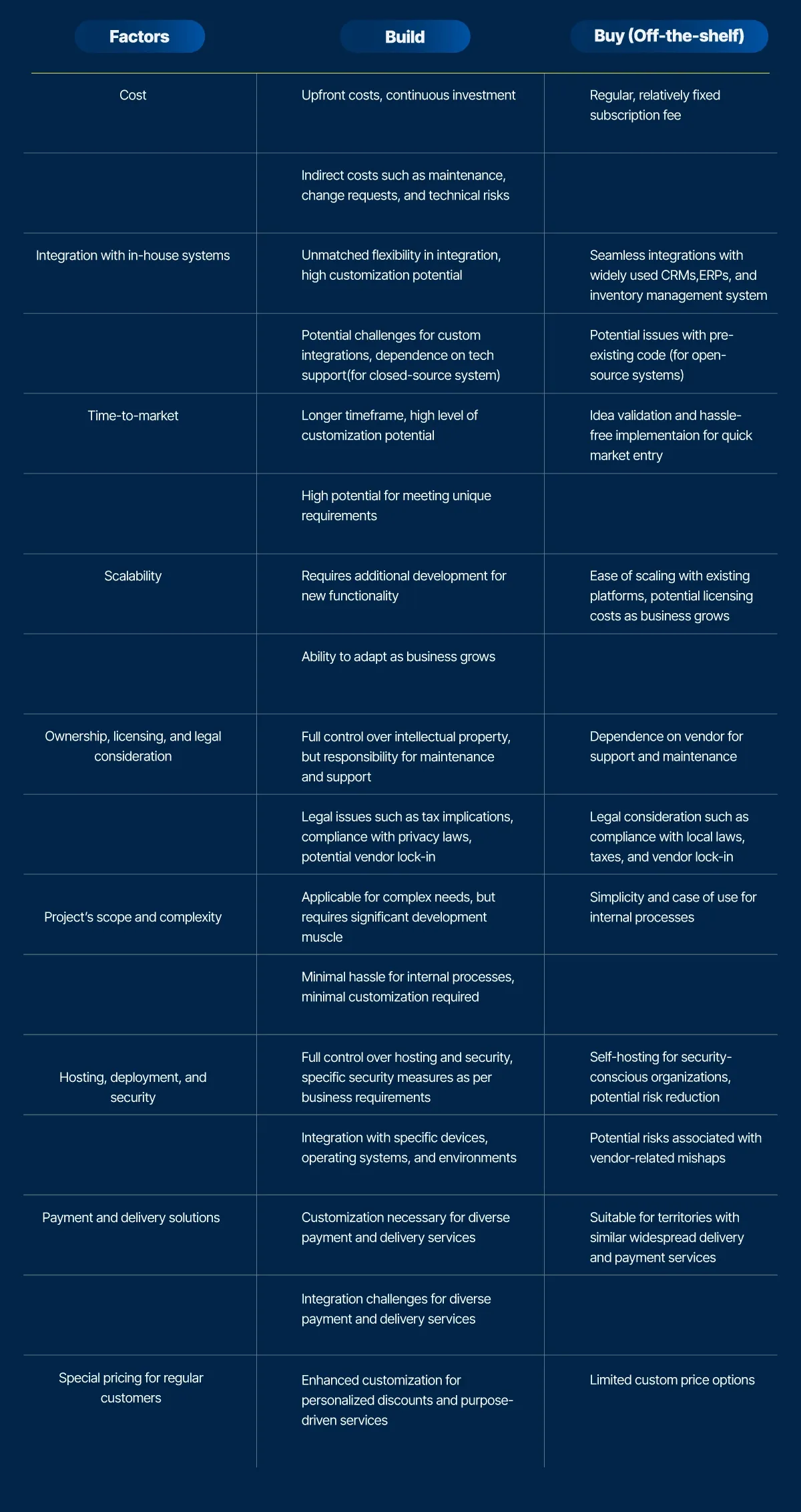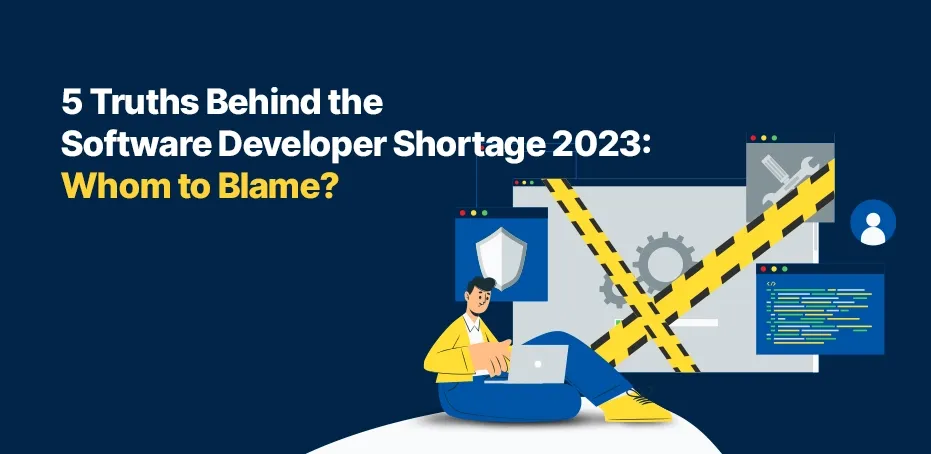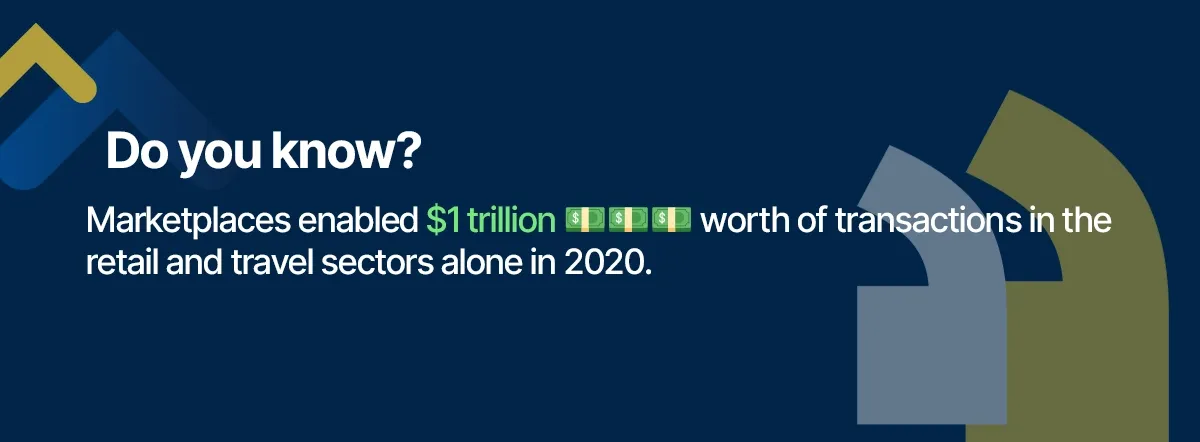E-commerce Marketplace Software: Decoding the Buy vs. Build Dilemma
What’s the biggest challenge when launching a marketplace?
- Finding the right investor?
- Managing customer data?
- Launching and managing your website?
- Creating a good user experience?
Truth be told, all of the above. :smiley:
But, what’s the hype about marketplaces?
Online shopping has become an integrated part of our post-pandemic life. Growing and advancing the e-commerce landscape has therefore become inevitable for businesses to grab all that consumer affection.
Consumers prefer marketplaces for easy buying experiences that give businesses great growth potential to offer various products and services, meeting changing market needs.
It is projected that this figure will grow by 15% annually until 2025.
Simply speaking, e-commerce marketplaces are a staple to grow at scale.
But the question isn't how to achieve a good customer experience but how to build that experience for them.
So, Is there a bigger problem?
Businesses planning to launch a marketplace often face a buy vs. build dilemma: Should they build it from scratch using internal resources or buy a platform from a technology vendor?
Getting overwhelmed when trying to understand the pros and cons of both options is normal. Besides, what works best for one business may not be ideal for another.
Interesting, right? Let’s solve the build-or-buy riddle and settle on the most fitting and profitable e-commerce solution for your venture.
What’s this build or buy dilemma? Let’s solve it
Marketplaces are the opportunity for businesses to expand the future of online shopping. As discussed earlier, choosing between or choosing both build vs. buy marketplace solutions is the real challenge for IT procurement teams.
Finding ways to achieve the best return on investment is crucial when deciding between the two options.
However, this isn't just about direct costs. Indeed, it's quite a puzzle to solve.
To make the right choice, you should thoroughly understand what influences your decision when it comes to launching your marketplace.
Let’s suppose your business needs a new delivery truck. You’ll most likely consider these options:
Option 1: You visit a dealership and buy the truck closest to your business needs.
Option 2: You construct a new truck from the start using total customization of every part to match your exact requirements.
For big companies, making a custom vehicle might be a great idea. But for small businesses or startups, building a truck can be tough because of time and money constraints.
Getting the most bang for your buck is the biggest challenge. Many factors influence cost-effectiveness, which can ultimately overwhelm stakeholders.
Maintaining a data-driven, analytical approach is the key here.
Buy or build your marketplace software? Decide wisely
There are a lot of moving parts at play here. Let’s ask the right questions to find the right answers.
What is more cost-effective: Building or buying your software?
Great marketplace launches entail considerable resources and decision-making. That said:

According to a recent Forrester study sponsored by Nautical, over half of the firms spent $3M or more to launch their marketplace, while 100% of respondents hired more employees to help with its adoption and management. Nearly half hired more than 15 employees.

Whether you purchase a platform or develop your own, costs are involved. The investment you make is substantial and sustainable over the next five years.
Making a direct cost comparison is challenging for several reasons. Software product costs are structured in different ways while custom builds come with diverse pricing models.
Custom-built software requires upfront costs, which primarily include development hours and labor charges from in-house developers or external vendors.
While custom pricing models can be beneficial in certain situations, there can be indirect costs such as maintenance, change requests, and technical risks if not fixed earlier.
On the contrary, most off-the-shelf software platforms leverage a SaaS model. Users pay a fixed subscription fee on an annual or monthly basis per user. It results in a regular, relatively fixed cost, depending on how long the platform is needed.
Honestly, it's difficult to compare the costs of custom builds versus off-the-shelf software platforms as it is highly contextual.
When considering the profitability of a solution, it's important to weigh in other key decision factors besides cost.
Are you confident in your business strategy, and are you prepared for potential growth or changes in the near future?
If you’re launching your startup, using an out-of-the-box e-commerce solution can easily test your market potential. For example, you can determine if the ordering process is comfortable for your customers and if they are happy with the app’s functionality.
The outcome you get after implementing the off-the-shelf e-commerce solution foretells your future in acquiring new customers and increasing revenue, all without overspending resources.
A custom e-commerce solution may initially appear less appealing due to higher development costs, but it offers tailored functionality according to your business needs. However, there are potential risks if you’re unsure about your business’ growth in the short term.
For instance, your teams are located across various countries, or each team is responsible for a particular production stage.
Do you need integrations with your in-house systems?
When selecting a business system, it is essential to consider the integration-level compatibility with other systems in use.
Out-of-the-box marketplace solutions offer seamless integrations with widely used CRMs, ERPs, and inventory management systems. This allows businesses to optimize their operations through ERP integration and assure personalized customer experiences with CRM integration.
However, some businesses have unique processes that require custom-made systems that might not integrate with out-of-the-box e-commerce solutions.
Besides, if you’re thinking of combining custom CRM, ERP, or other business systems with off-the-shelf e-commerce solutions, it can pose integration challenges. Choosing a closed-source system will require your reliance on tech support for issue resolution, while open-source systems will demand dealing with pre-existing code.
Both choices demand significant time, effort, and financial investment.
With that said, custom marketplace solutions offer unmatched flexibility in integration as they can adjust with any in-house infrastructure. However, building a custom-made system can be time-consuming, expensive, and require technical support.
Therefore, when making a decision always look for available solutions available in the market that are very close to your business's needs.
Many business processes follow generic patterns, making out-of-the-box solutions highly effective for managing them. To narrow down your search, ensure that your made-to-use marketplace solution has needed integrations and features tailored to your business demands.
Look for these features when choosing off-the-shelf marketplace software:
- Integrability across platforms and data sources for efficient workflows.
- Consider features like hosting, deployment, automation, data processing, security, and customization.
- Assess if the software stack is compatible with in-house multiple platforms.
- Ensure compatibility of each tool within the system for smooth operation.
You can eliminate off-the-shelf tools that don’t provide needed integrations and functionalities straight off the bat.
Simply speaking, if the new solution doesn’t support the in-house systems then there’s no reason to run it. Look for compatible options.
Do you have enough time to build vs buy software? Is time-to-market crucial for you?
Marketplaces require a long runway to launch, even for firms that purchase their platform straight from a vendor. 66% of Forrester’s respondents took over six months to launch their marketplaces, while 36% needed over a year.
When deciding whether to build or buy software, consider how much time and money it will take to create your ideal solution from scratch, as well as the cost of buying a workable solution that is also sustainable over the next five years.
It's equally important to consider the capabilities of the software you need.
Choosing an existing product that meets your needs over building from scratch can save time and money. Out-of-the-box marketplace solutions offer hassle-free implementation, making them perfect for startups seeking quick market entry and idea validation without extensive development.
In comparison, traditional custom builds can take months to become business-specific meeting unique requirements. According to the Unilog annual B2B digital commerce report, over half of the respondents reported that implementing a custom e-commerce solution took more than 9 months.
However, time-to-market becomes less of a priority when you require a bespoke solution or integration with custom ERP, CRM, or BI systems crucial for efficient business operations. Besides, human-friendly technologies like low-code development are changing the equation.
In scenarios where there's an urgent need for solutions, IT teams face significant challenges.
Firstly, gathering adequate development resources internally to build the solution.
Secondly, assessing whether the development team can deliver within the required timeframe.
However, implementing a haywire solution quickly loses its value if it fails to meet your needs. In cases where off-the-shelf solutions aren't viable, building your own may be the only option.
Yet, some scenarios fall into a grey area.
For example, if a tool on the market fulfills 90% of your requirements, skipping the 10% and making a short-term compromise may be the most practical yet time-effective decision.
In another case, buying and implementing a SaaS product may seem quick and cost-effective initially; but replacing it every two years because it fails to fit with your evolving business needs may inflate costs over time.
Likewise, building your marketplace software would require a capable development and project management team which is costly. But depending on old technology and inexperienced resources may cost you a failing future and almost no reputation.
Both situations are risky and time-critical.
Considering these factors and answering relevant questions you can make an informed decision about whether to build or buy software.
You might be interested in reading: Save Costs, Time, and Reputation with E-commerce Automation
How to ensure continuous business scalability?
What works for your business today might not work the same tomorrow. New challenges require technology adaptation to merge with the growing market.
Therefore, keeping scalability in account helps when deciding whether to build vs buy software.
There are two types of scalability to think about, vertical and horizontal scalability.
First up, there's vertical scalability, which means revving up what we already have i.e., adding more users, more data, or making performance-related improvements.
Scaling with off-the-shelf tools is easy but you may encounter licensing costs that increase as your business grows.
Then there's horizontal scalability, which is adding entirely new features, screens, functionalities, processes, access roles, or other elements to an existing tool. This one's a bit trickier.
If you use off-the-shelf solutions, you may have to wait for vendors to release the features you need, unless you're a high-ticket client. Sure, customization can help, but it's not a silver bullet.
On the flip side, building your product will require you to add new functionality yourself means more development work — and more costs.
Honestly, there's no ideal answer here. Predicting the future is tough enough, let alone figuring out the cheapest way to meet those future needs.
What ownership, licensing, and legal aspects you should consider?
There are several legal benchmarks to follow when making a business decision. Ownership, licensing, and legal considerations are important business-level decision points when buying or building e-commerce marketplace software.
Let's start with ownership.
When you build your own solution, it's all yours—your intellectual property, your rules. This is a big deal for some businesses, especially in highly mission-critical areas like enterprise solutions.
Ownership gives you the power to control exactly how your tool is built, deployed, used, and managed. But, owning it also means owning all the headaches: risk, maintenance, support, incident responses, and administrative work.
In the case of off-the-shelf solutions, you'll depend on the vendor for support, maintenance, and product performance through SLAs as part of your license. However, you must vet SLAs and licenses to understand where liabilities fall.
Then there are legal issues depending on the nature and location of your business. For example, tax implications in your jurisdiction for custom internal builds, compliance with local privacy laws, and associated costs in the process.
And let's not forget about vendor lock-in. Relying too heavily on an off-the-shelf solution can leave you at the mercy of price hikes, service cuts, or other surprises down the road.
How can you factor in your project’s scope and complexity?
Your project’s size can greatly affect the build vs. buy decision for software. The more complex your needs, the more development muscle you'll need to flex.
So, when is building in-house a smarter move? Well, there's a sweet spot where complexity meets customization. You're not likely to reinvent the wheel with your own CRM or ERP system unless you have some seriously unique requirements unavailable off the shelf.
In most cases, the benefits of building software in-house do not outweigh the costs. It's just not worth the hassle to build from scratch unless you've got some seriously specific needs that can't be met another way.
The cost-benefit scale points towards off-the-shelf solutions. Most ready-to-use tools are made quite simple to fit into your internal processes; relieving you from reinventing the digital wheel.
Which payment and delivery solutions to use for global reach?
Out-of-the-box solutions work for the territories with similar widespread delivery (FedEx, DPD, etc.) and payment services such as PayPal, Visa, Mastercard, etc.
However, for targeting countries with diverse payment and delivery services, a custom solution may help. For example, PayPal isn't available in certain regions like China and parts of Eastern Europe. You'll need alternative payment options integrated into your e-commerce platform to tap into these markets.
The same works for shipping — there are countries where the delivery service offered within your off-the-shelf solution isn’t available.
Wan to know Why Automate Your eCommerce Business?
Do you plan to offer special pricing for regular customers?
Considering whether to offer special pricing for regular customers depends on your needs for personalization and customer retention.
Out-of-the-box solutions offer some level of personalization, such as recommending products based on customer demographics or browsing history. However, they may have limited custom pricing options or advanced services like order tracking and detailed order history.
If you prioritize establishing a loyal customer base via personalized discounts and purpose-driven services, a custom solution is your answer. Custom-built marketplace solution helps you offer multiple pricing and service options, ultimately enhancing your customers’ shopping experience and increasing loyalty.
Treating your customers as individuals with unique needs can greatly facilitate their buying journey.

You better make the right choice.
Are hosting, deployment, and security an issue?
Let's wrap things up by considering how your hosting, deployment, and security needs impact the build vs. buy decision for marketplace software.
For big security-conscious organizations, self-hosting is often non-negotiable. They need full control to meet their security standards, almost ruling out many off-the-shelf options. The same goes for compatibility with specific devices, operating systems, and environments.
Regardless of your business’ size, having the ability to implement specific security measures is crucial. For example, using existing SSO, authentication, and sign-on tools. Plus, some businesses feel safer keeping everything in-house, reducing the risk of vendor-related mishaps like data breaches or downtime.
So, when it comes down to it, sometimes building your own solution is less about tech and more about peace of mind.
It's all about minimizing risk and keeping control where it counts.

Building Custom Solutions: Pros and Cons
Here's a comparison table outlining the pros and cons of building custom solutions:
This comparison provides a clear overview of the advantages and disadvantages of building custom solutions, allowing for a more informed decision-making process.
Off-the-Shelf Software Solutions: Pros and Cons
Now comes a quick comparison of the pros and cons of buying an e-commerce marketplace solution:
Surprise! The answer is “buy and build” and not “buy vs. build”
Launching a new platform is not only about choosing between building from scratch or buying off-the-shelf.
Building a platform may offer powerful customer experiences, however, it's often costly, time-consuming, and may lead to lower adoption rates in comparison to off-the-shelf solutions
However, availing of complete customization isn't always possible with ready-made solutions.
Finding the right balance between buying and building your marketplace software is the key.
The convergence allows businesses to easily offload backend complexities while retaining control over the front end to deliver a truly personalized customer journey.
Businesses that prefer to invest in this hybrid approach can leverage necessary backend features for workflow management and multi-vendor support. While building the front end helps businesses enjoy flexibility and customization options.
This decision rewards businesses with more space for productivity and big growth.
You might also like…

Is 2024 The Year of Software Development Crisis?

5 Truths Behind the Software Developer Shortage 2024: Whom to Blame?



